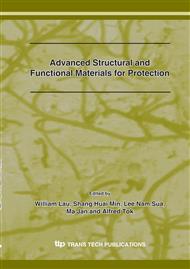[1]
J.T. Cutchen, J. Harris, Applied Optics, Vol. 14(1975), pp.1866-1873.
Google Scholar
[2]
Trapani, Giorgio B, US. Patent 4201450. (1980).
Google Scholar
[3]
Reininger, Siegfried, Wiesmeier, et al, USPatent 4572619, (1986).
Google Scholar
[4]
Bylander; E. Gerald, US. Patent 5654786. (1997).
Google Scholar
[5]
G.W. Gobeli, A.N. Mex, US. Patent 5768003. (June, 1998).
Google Scholar
[6]
A.A. BerezhnoÏ, A. A. Berezhnaya, Optics and Spectroscopy, Vol. 94. (2003), pp.216-220.
Google Scholar
[7]
F.F. Lange, Science, New series, Vol. 273 (1996), pp.903-909.
Google Scholar
[8]
H. KOZUKA,S. Takenaka,H. Tokita, T. Hirano,Y. Higashi, T. Hamatani, J. Sol-Gel Sci. Tech. Vol. 26(2003), pp.681-6.
DOI: 10.1023/a:1020773415962
Google Scholar
[9]
H. KOZUKA, M. Kajimura, T. Hirano,K. Katayama, J. Sol-Gel Sci. Tech. Vol. 19(2000), p.205209.
Google Scholar
[10]
H. Kozuka, S. Takenaka, H. Tokita, M. Okubayashi,J. Europ. Ceram. Soc., Vol. 24(2004), pp.1585-88.
Google Scholar
[11]
S. Takenaka, H. Kozuka, Appl. Phys. Lett., Vol. 79(2001), pp.3485-3487.
Google Scholar
[12]
T. Atsuki, N. Soyama, G. Sasaki, T. Yonezawa, K. Ogi, K. Sameshima, K. Hoshiba, Y. Nakao, A. Kamisawa, Jpn.J. Appl. Phys. Vol. 33(1994), p.5196.
DOI: 10.1143/jjap.33.5196
Google Scholar
[13]
K.S. HWANG, Y.H. YUN, B.A. KANG, Y.H. KIM, J. Mater. Sci., Vol. 37(2002), pp.365-368.
Google Scholar
[14]
J. Ricotea, E. Snoeck, R. Coratger, L. Pardo, J. Phys. Chem. Solids, Vol. 59(1998), pp.151-157.
Google Scholar
[15]
Y. TKwon, I. -M. Lee, W.I. Lee, C.J. Kim, I.K. Yoo, Materials Research Bulletin, Vol. 34(1999), pp.749-760.
Google Scholar
[16]
Z. H. Du, T.S. Zhang, J. Ma, J. Mater. Res., Vol(22)(2007), pp.2195-2203.
Google Scholar
[17]
J.S. Lee, C.J. Kim, D.S. Yoon, C.G. Choi, J.M. Kim, K. No, Jpn.J. Appl. Phys., Vol. 33, Part 1(1994), pp.260-265.
Google Scholar
[18]
R. Kurchania, S.J. Milne, J. Mater. Sci., Vol. 33(1998), pp.659-667.
Google Scholar
[19]
G.J. Derderian, J.D. Barrie, K.A. Aitchison, P.M. Adams, M.L. Mecartney, J. Am. Ceram. Soc., Vol. 77(1994), pp.820-28.
Google Scholar
[20]
L. Amarande, C. Miclea, C. Tanasoiu, J. Europ. Ceram. Soc., Vol. 22(2002), pp.1269-1275.
Google Scholar
[21]
C.H. Wang, J. Europ. Ceram. Soc. ,Vol. 22(2002), p.2033-(2038).
Google Scholar
[22]
L.B. Kong, J. Ma, H. Huang, R.F. Zhang, J. Alloys and compounds, Vol. 345(2002), 238-245.
Google Scholar
[23]
K. Tsuzuku, T. Kobayashi, Jpn.J. Appl. Phys., Part1, Vol. 42(2003), p.6027.
Google Scholar


